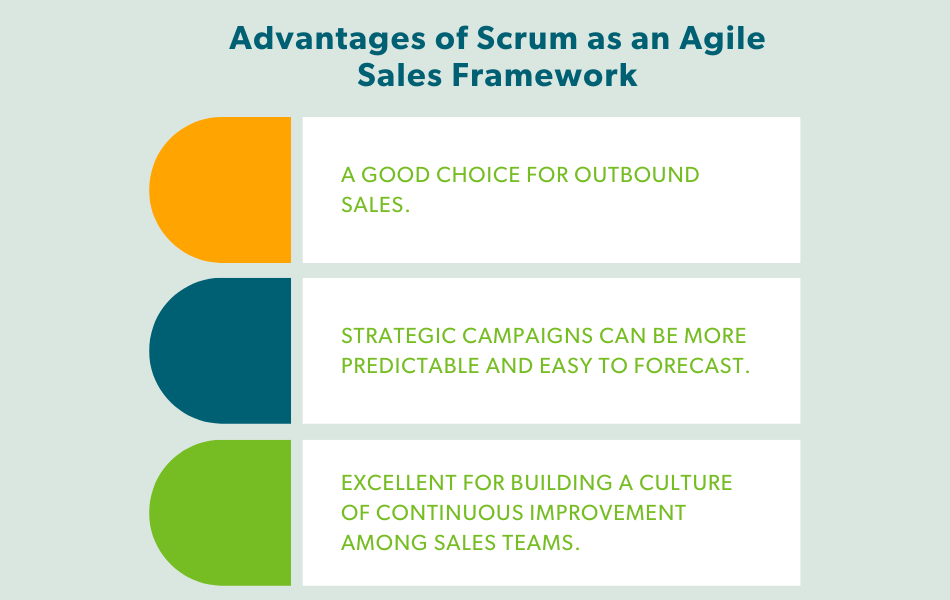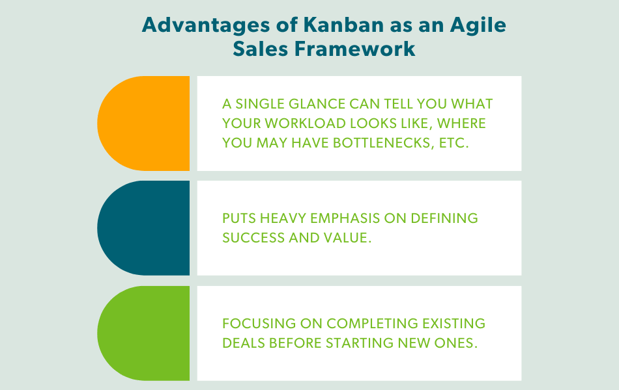Sales teams need Agile today more than ever. Customer expectations, markets that evolve at their fastest rate yet, supply chain difficulties, and more mean that the old ways of managing sales teams just aren’t cutting it. Sales need to be adaptive, iterative, and customer focused and Agile empowers them to do just that.
That said, Agile sales isn’t just one single thing. There are many approaches and frameworks. If you’re new to Agile sales and just want to understand what it is, we recommend you begin with our previous Agile sales article.
But if you already know that Agile sales is the right path and need to understand the various ways to approach it, this article is for you. Below, we’ll break down the three primary frameworks Agile sales teams are using, their advantages and disadvantages, and how to choose the one that’s right for you.
Scrummy Sales
Scrum is an Agile framework designed for small teams (usually fewer than 10 people) who are working together on a project. It aims to harness everyone’s abilities to work towards a common goal.
Another key element of Scrum is that it’s generally very well defined, relying on a strict set of processes. Teams are cross-functional, so the idea is that everything required to complete the team’s tasks can be done by someone in the team without external dependencies. Teams are led by a scrum master who oversees the overall process.
Work is broken up into “sprints” usually consisting of one to a few weeks. These begin with creating a backlog of work that will be completed during that active period of work. In most cases, new work isn’t accepted in the middle of a sprint to ensure everyone can focus on a small set of priorities.
During sprints, most days will begin with a daily standup focusing on what everyone did the day before, will do today, and whether they have anything preventing them from achieving what they need to. Then, once the sprint is over, you will do a sprint review and retrospective to update on your progress and discover ways to optimize the work process, respectively. Then the process starts over again.
Advantages of Scrum as an Agile Sales Framework

In general, Scrum can be a good choice for outbound sales efforts in which the team runs outreach campaigns. These kinds of proactive, strategic campaigns can be broken up into sprints, making the entire process more predictable and easy to forecast. It’s a bit like when you have a huge task ahead of you and breaking it into smaller pieces makes it easier to track your progress. Finding a way to fit your sales process into distinctive sprints provides is the main challenge of adapting Scrum to Agile sales.
Otherwise, Scrum offers some key advantages. There’s a lot of transparency as daily standups clarify exactly what is happening on a day-to-day basis. In addition, the structure of sprint retrospectives helps ensure that sales teams regularly take the time to evaluate their work and find ways to improve. This is why Scrum is excellent for building a culture of continuous improvement among sales teams. Instead of the usual “everyone for themselves” sales style, teams share ownership over the outcomes of their sprints.
Disadvantages of Scrum as an Agile Sales Framework
Perhaps the biggest disadvantage of Scrum for Agile Sales is that it’s not continuous. If your sales process doesn’t have any fixed start or end points, then it may be difficult to break it into distinct sprints with specific goals.
Then there’s the flip side of the teamwork mentioned above. While getting salespeople to collaborate more is great, that doesn’t make it easy. Transitioning to a culture in which sales teams all work together can be tricky when people are so used to working individually.
It can also be difficult to find someone who can function as a Scrum Master, as this role requires at least some training. Otherwise, some salespeople may not like daily meetings and feel this takes time away from their “real work.” Finally, as was noted above, Scrum can be difficult to implement for large sales teams, as having too many people on a team slows down many of the Scrum processes.
Kanban-esque Sales
Compared to Scrum, Kanban is a less structured and more adaptable Agile framework. At its core, it’s a visual workflow management system based on using work items represented by cards (physical or digital) which are moved through columns to represent priorities, status, etc.
Kanban is designed to give you high levels of visibility and autonomy as everyone on the team can easily see what team members are working on, what the priorities are, and has access to all the relevant information/materials listed on each card. You can see the sample Kanban board below to get an idea of what this looks like in practice.
In the sales context, it’s worth noting that Kanban is derived from Lean principles (both originated in Japan). So if you were already interested in the waste reduction practices of Lean Sales but were concerned about implementation, Kanban is a fantastic way to more easily access much of the value Lean provides.
Advantages of Kanban as an Agile Sales Framework

As noted above, first and foremost Kanban is amazing for visualizing work. A single glance can tell you what your workload looks like, where you may have bottlenecks, etc. For sales, this may be something like noticing that many deals are stuck in negotiations.
Done properly, Kanban also puts heavy emphasis on defining success and value in cards. For sales, this can translate into an effective way to get salespeople to focus on the metrics that matter and ignore irrelevant vanity metrics.
Another core tenet of Kanban is limiting Work In Progress (WIP). For salespeople, this means focusing on completing existing deals before starting new ones. This system also encourages collaboration (something sorely lacking in most sales teams) by making it simple to request help, and see what colleagues are doing.
Overall then, these advantages make Kanban a good choice for sales teams which put heavy emphasis on being responsive (i.e. inbound sales). This can take the form of “swarming” in which everyone (or nearly everyone) on a team focuses together on a single task until it’s complete. So if a once-in-a-lifetime sales opportunity arises, your sales teams can swarm to ensure it gets the best possible chance of success.
That said, there are also some real downsides to consider.
Disadvantages of Kanban as an Agile Sales Framework
The biggest single challenge most sales organizations face when trying to implement Kanban as an Agile sales framework is the lack of distinct cadences, like we have in Scrum. Classic Kanban is a continuous process, so if your sales setup is divided into specific phases based on something like quarters, this can be a problem.
Otherwise, some sales teams may find it difficult or tedious to maintain a Kanban board, although this is usually something that simply has to be built into the culture over time. In particular, salespeople who are used to being highly independent may feel like they’re now being micromanaged due to the granularity of task tracking in Kanban. In most cases, however, once salespeople see the value Kanban provides, they get better at board maintenance.
Hybridizing Sales Processes
In the end, Agile frameworks like Scrum and Kanban weren’t originally designed for the sales context. This is why, in most cases, sales teams choose to take the hybrid approach to applying them. This combines elements of Scrum and Kanban, occasionally with some other tweaks, to better suit a sales team’s unique needs.
The most popular hybrid approach is Scrumban. This takes the distinct phases, daily standups, retrospectives, etc. from Scrum but uses a Kanban board to track them.
Advantages of a Hybrid Agile Sales Framework
Hybrid approaches like Scrumban enable teams to combine the excellent visualization and transparency of Kanban with the structure and laser focus on small batches of work in Scrum.
This approach has proven exceptionally successful in the marketing world for the same reasons, with a recent survey finding that 61% of Agile marketing teams use a hybrid framework. Marketing and sales have their differences, but many of the advantages hybrid offers appeal to both functions.
Disadvantages of a Hybrid Agile Sales Framework
Unfortunately, the more you customize your Agile sales approach, the greater the chance you unwittingly create issues. You may decide you don’t need a Scrum Master, for example, only to find that your Scrumban processes are chaotic as a result.
Or, you may decide that your sprints will each last an entire quarter because that’s how you’ve always divided your sales calendar. The problem is that this is far longer than sprints are supposed to last, leading to extremely long delays in retrospectives and implementing learnings. Without experience in implementing Agile in sales, it can be difficult to always foresee precisely how a change in how you implement it will affect you.
Hybrid Frameworks Built In Partnership With Experts
In the end, the best Agile sales framework for you largely depends on the type of sales you’re engaged in, what your goals are, and the type of work you’re doing. Scrum has advantages for outbound while Kanban is appealing for inbound.
Ultimately, however, for most Agile sales teams, a hybrid, custom approach will be ideal. So what can you do to avoid the potential pitfall of tailoring your Agile framework beyond what is optimal? Working with seasoned Agile experts who can both help you craft the perfect Agile sales framework for your needs and, in particular, use their experience to help you avoid common mistakes is the most effective approach.
Fortunately, we have the experience you need to lead a successful Agile sales transition. So get in touch to see how we can help you achieve your Agile goals.